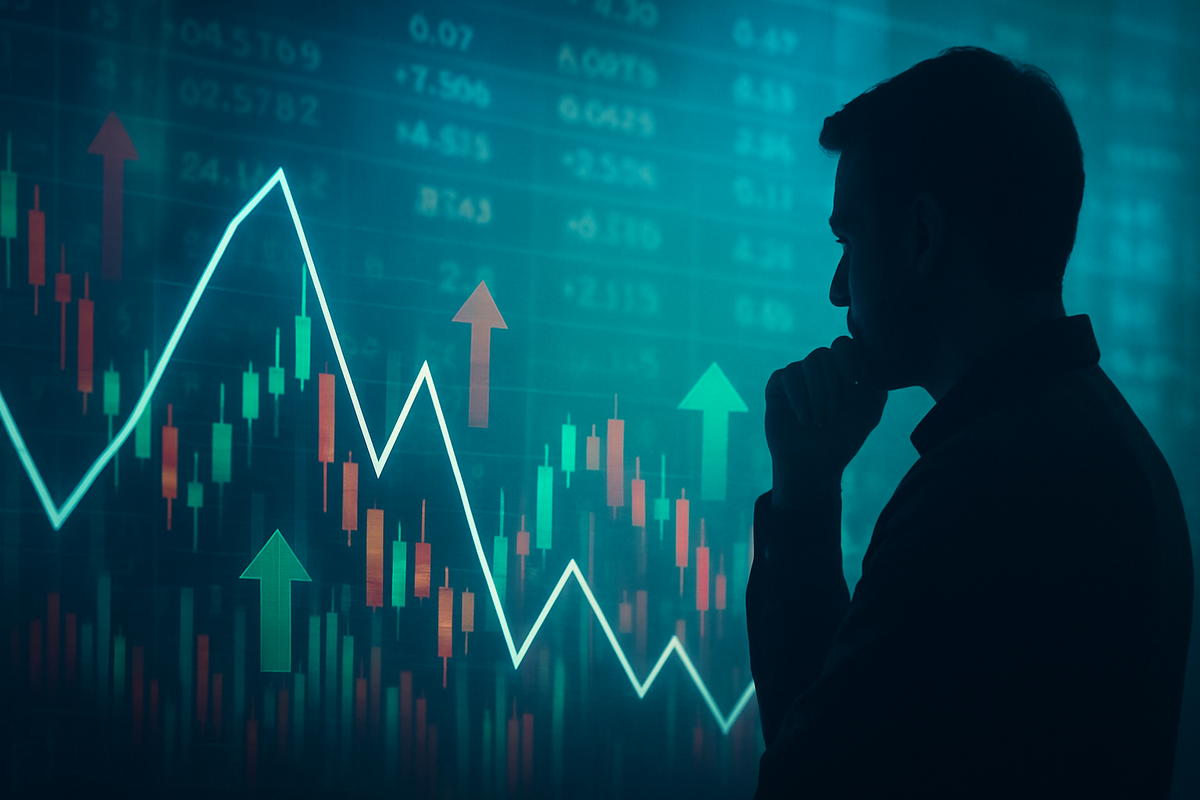
In the dynamic world of financial markets, volatility stands as a constant, yet often unsettling, companion. It describes the magnitude and frequency of price fluctuations in assets like stocks, bonds, and commodities, acting as a crucial barometer for risk and uncertainty. While often perceived negatively, associated with sharp declines, volatility simply signifies significant price movements in either direction. However, its unpredictable nature profoundly shapes investor sentiment and decision-making, often pushing individuals and institutions alike to reassess their strategies and emotional resilience.
The immediate implication of an unpredictable market environment is a heightened sense of anxiety and caution among market participants. Periods of increased volatility can trigger a flight to safety, as investors pull capital from riskier assets in favor of perceived havens like government bonds or gold. This reactive behavior, driven by fear of potential losses, can lead to widespread panic selling, often at inopportune times, and can significantly alter the landscape for public companies and the broader economy.
The Shifting Sands: Unpacking Market Volatility
Market volatility, a measure of how much and how quickly asset prices change, is a complex phenomenon driven by a confluence of economic, political, and corporate factors. Historically, it's been a hallmark of financial markets, manifesting as sudden surges or steep declines that challenge even the most seasoned investors. The CBOE Volatility Index (VIX), often dubbed the "fear gauge," serves as a real-time indicator, reflecting the market's expectation of future volatility in the S&P 500 index over the next 30 days. A higher VIX reading typically signals greater market uncertainty and investor apprehension.
The timeline leading to periods of heightened volatility is rarely linear. It often begins with a series of unsettling macroeconomic data releases, such as unexpected inflation figures, shifts in interest rate policy by central banks like the Federal Reserve, or disappointing employment reports. Geopolitical tensions, ranging from trade disputes to international conflicts, also frequently act as significant catalysts, injecting uncertainty into global supply chains and economic forecasts. Furthermore, major corporate announcements, be it a surprising earnings miss or a significant merger and acquisition deal, can ripple through specific sectors and even the broader market if the company is a major player.
Key players and stakeholders in this environment include individual retail investors, large institutional investors (e.g., pension funds, hedge funds), corporations, and central banks. Each group reacts to and, in turn, influences market movements. Retail investors, often driven by sentiment and media headlines, can contribute to rapid swings through collective buying or selling. Institutional investors, with their vast capital, can significantly impact liquidity and price discovery. Corporations, through their earnings and guidance, directly affect stock performance, while central banks, via monetary policy, exert a powerful influence on the overall economic climate and, consequently, market stability. Initial market reactions to significant volatility are typically characterized by increased trading volumes, wider bid-ask spreads, and a general shift towards more defensive assets.
Winners and Losers in a Turbulent Market
An unpredictable market environment invariably creates distinct winners and losers among public companies. Companies with strong balance sheets, consistent cash flows, and robust business models often fare better during volatile periods. These "quality" stocks, typically found in defensive sectors such as utilities (e.g., NextEra Energy (NYSE: NEE)), consumer staples (e.g., Procter & Gamble (NYSE: PG)), and healthcare (e.g., Johnson & Johnson (NYSE: JNJ)), tend to exhibit lower beta values, meaning their stock prices fluctuate less dramatically than the broader market. Their stable demand for products and services makes them attractive safe havens for investors seeking to preserve capital.
Conversely, companies heavily reliant on consumer discretionary spending, those with high debt loads, or growth stocks with speculative valuations often struggle. Technology companies (e.g., Tesla (NASDAQ: TSLA), NVIDIA (NASDAQ: NVDA)) and other high-growth sectors, while offering significant upside in bull markets, can experience sharper corrections during downturns as investors become more risk-averse and prioritize profitability over future growth potential. Similarly, cyclical industries like airlines (e.g., Delta Air Lines (NYSE: DAL)) or luxury goods retailers (e.g., LVMH Moët Hennessy Louis Vuitton (EPA: MC)) are particularly vulnerable to economic slowdowns that often accompany periods of heightened volatility.
The impact on these companies is multifaceted. For those in defensive sectors, stable performance can attract new investment, potentially bolstering their market capitalization and providing opportunities for strategic acquisitions. For more vulnerable companies, volatility can lead to significant share price depreciation, making it harder to raise capital, increasing the cost of debt, and potentially triggering layoffs or project delays. Furthermore, companies with significant international exposure can face additional headwinds from currency fluctuations exacerbated by global economic uncertainty.
Broader Implications and Historical Context
The current state of market volatility, while unique in its specific triggers, fits into broader industry trends marked by increased interconnectedness and rapid information dissemination. The rise of algorithmic trading and social media's influence on investor sentiment means that market reactions can be instantaneous and amplified, creating flash crashes or rapid rallies that were less common in previous decades. This interconnectedness means that a crisis in one part of the world or sector can quickly cascade, creating ripple effects across global markets and impacting seemingly unrelated competitors and partners.
Regulatory bodies worldwide are constantly grappling with the implications of this accelerated market environment. Discussions often revolve around circuit breakers, trading halts, and stricter oversight of high-frequency trading to mitigate excessive volatility. Policymakers also face the challenge of using fiscal and monetary tools to stabilize economies without inadvertently fueling asset bubbles or exacerbating inflation. The lessons from historical precedents, such as the 2008 financial crisis or the dot-com bust of the early 2000s, serve as stark reminders of how unchecked risk and speculative fervor, often preceding periods of high volatility, can lead to severe economic contractions.
Comparing current market dynamics to past events reveals both similarities and crucial differences. While the underlying human emotions of fear and greed remain constant drivers, the technological infrastructure of today's markets introduces new variables. The speed at which information (and misinformation) travels, coupled with the accessibility of trading platforms, means that retail investors play a more significant role than ever before. This democratized access, while beneficial in many ways, also means that herd mentality can spread more rapidly, potentially amplifying market swings.
What Comes Next: Navigating the Future Landscape
Looking ahead, the short-term possibilities for market volatility suggest a continued period of choppiness, particularly if economic data remains mixed or geopolitical tensions persist. Investors should anticipate further price swings and be prepared for potential drawdowns. In the long term, however, markets historically tend to recover and trend upwards, albeit with intermittent periods of turbulence. The key lies in distinguishing between temporary corrections and fundamental shifts in economic paradigms.
For companies, strategic pivots and adaptations will be crucial. This may involve strengthening balance sheets, diversifying revenue streams, focusing on cost efficiencies, and investing in resilient supply chains. Companies that can demonstrate adaptability and maintain strong customer relationships are better positioned to weather the storm. Furthermore, innovation, particularly in areas like artificial intelligence, renewable energy, and biotechnology, may continue to attract investment even during volatile times, as these sectors are seen as drivers of future growth.
Market opportunities may emerge for astute investors willing to buy quality assets at discounted prices during downturns. Value investing, which focuses on identifying undervalued companies, can become particularly appealing. Conversely, challenges include the risk of capital erosion for those who panic sell, and the difficulty of timing the market effectively. Potential scenarios range from a gradual stabilization and recovery, driven by improving economic fundamentals and clarity on interest rate policies, to prolonged periods of uncertainty if inflation proves persistent or new geopolitical crises emerge.
A Comprehensive Wrap-Up: Enduring Lessons and Future Watchpoints
In summary, market volatility is an inherent and unavoidable aspect of financial markets, serving as a constant test of investor resolve and strategic planning. Its profound impact extends beyond mere price fluctuations, deeply influencing investor sentiment, risk appetite, and the operational strategies of public companies. While periods of high volatility can be unsettling, they also underscore the importance of disciplined investing, diversification, and a long-term perspective.
Moving forward, the market will likely remain susceptible to shifts in economic indicators, central bank policies, and global events. Investors should be prepared for continued unpredictability and understand that short-term noise often obscures long-term value creation. The ability to distinguish between temporary market reactions and fundamental shifts will be paramount for successful navigation.
For the coming months, investors should closely watch several key indicators: inflation data, central bank communications regarding interest rates, corporate earnings reports for signs of resilience or weakness, and any significant geopolitical developments. Maintaining a diversified portfolio, practicing dollar-cost averaging, and avoiding emotional decision-making will remain cornerstone strategies. Ultimately, understanding volatility not as an enemy, but as a natural market rhythm, can empower investors to make more informed and resilient choices.
This content is intended for informational purposes only and is not financial advice



